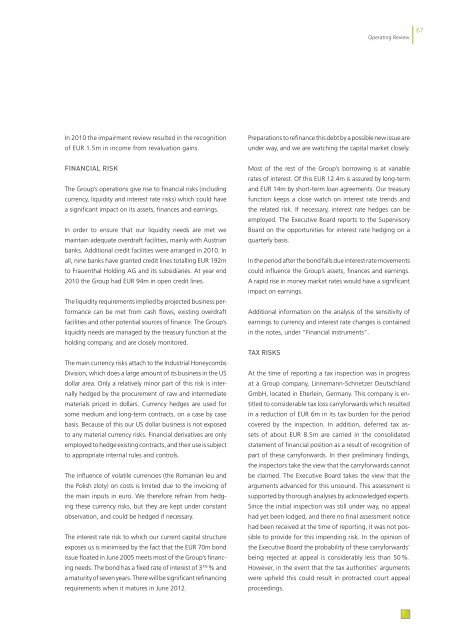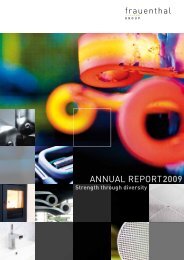Annual Report 2010 - Frauenthal Holding AG
Annual Report 2010 - Frauenthal Holding AG
Annual Report 2010 - Frauenthal Holding AG
Create successful ePaper yourself
Turn your PDF publications into a flip-book with our unique Google optimized e-Paper software.
In <strong>2010</strong> the impairment review resulted in the recognition<br />
of EUR 1.5m in income from revaluation gains.<br />
FinanCial riSk<br />
The Group’s operations give rise to financial risks (including<br />
currency, liquidity and interest rate risks) which could have<br />
a significant impact on its assets, finances and earnings.<br />
In order to ensure that our liquidity needs are met we<br />
maintain adequate overdraft facilities, mainly with Austrian<br />
banks. Additional credit facilities were arranged in <strong>2010</strong>. In<br />
all, nine banks have granted credit lines totalling EUR 192m<br />
to <strong>Frauenthal</strong> <strong>Holding</strong> <strong>AG</strong> and its subsidiaries. At year end<br />
<strong>2010</strong> the Group had EUR 94m in open credit lines.<br />
The liquidity requirements implied by projected business performance<br />
can be met from cash flows, existing overdraft<br />
facilities and other potential sources of finance. The Group’s<br />
liquidity needs are managed by the treasury function at the<br />
holding company, and are closely monitored.<br />
The main currency risks attach to the Industrial Honeycombs<br />
Division, which does a large amount of its business in the US<br />
dollar area. Only a relatively minor part of this risk is internally<br />
hedged by the procurement of raw and intermediate<br />
materials priced in dollars. Currency hedges are used for<br />
some medium and long-term contracts, on a case by case<br />
basis. Because of this our US dollar business is not exposed<br />
to any material currency risks. Financial derivatives are only<br />
employed to hedge existing contracts, and their use is subject<br />
to appropriate internal rules and controls.<br />
The influence of volatile currencies (the Romanian leu and<br />
the Polish zloty) on costs is limited due to the invoicing of<br />
the main inputs in euro. We therefore refrain from hedging<br />
these currency risks, but they are kept under constant<br />
observation, and could be hedged if necessary.<br />
The interest rate risk to which our current capital structure<br />
exposes us is minimised by the fact that the EUR 70m bond<br />
issue floated in June 2005 meets most of the Group’s financing<br />
needs. The bond has a fixed rate of interest of 37/8 % and<br />
a maturity of seven years. There will be significant refinancing<br />
requirements when it matures in June 2012.<br />
Operating Review<br />
Preparations to refinance this debt by a possible new issue are<br />
under way, and we are watching the capital market closely.<br />
Most of the rest of the Group’s borrowing is at variable<br />
rates of interest. Of this EUR 12.4m is assured by long-term<br />
and EUR 14m by short-term loan agreements. Our treasury<br />
function keeps a close watch on interest rate trends and<br />
the related risk. If necessary, interest rate hedges can be<br />
employed. The Executive Board reports to the Supervisory<br />
Board on the opportunities for interest rate hedging on a<br />
quarterly basis.<br />
In the period after the bond falls due interest rate movements<br />
could influence the Group’s assets, finances and earnings.<br />
A rapid rise in money market rates would have a significant<br />
impact on earnings.<br />
Additional information on the analysis of the sensitivity of<br />
earnings to currency and interest rate changes is contained<br />
in the notes, under “Financial instruments”.<br />
taX riSkS<br />
At the time of reporting a tax inspection was in progress<br />
at a Group company, Linnemann-Schnetzer Deutschland<br />
GmbH, located in Elterlein, Germany. This company is entitled<br />
to considerable tax loss carryforwards which resulted<br />
in a reduction of EUR 6m in its tax burden for the period<br />
covered by the inspection. In addition, deferred tax assets<br />
of about EUR 8.5m are carried in the consolidated<br />
statement of financial position as a result of recognition of<br />
part of these carryforwards. In their preliminary findings,<br />
the inspectors take the view that the carryforwards cannot<br />
be claimed. The Executive Board takes the view that the<br />
arguments advanced for this unsound. This assessment is<br />
supported by thorough analyses by acknowledged experts.<br />
Since the initial inspection was still under way, no appeal<br />
had yet been lodged, and there no final assessment notice<br />
had been received at the time of reporting, it was not possible<br />
to provide for this impending risk. In the opinion of<br />
the Executive Board the probability of these carryforwards’<br />
being rejected at appeal is considerably less than 50 %.<br />
However, in the event that the tax authorities’ arguments<br />
were upheld this could result in protracted court appeal<br />
proceedings.<br />
67




